Chapter: Analysis and Design of Algorithm : Dynamic programming
Dynamic programming
DYNAMIC PROGRAMMING
Dynamic
programming is a technique for solving problems with overlapping subproblems.
Typically, these subproblems arise from a recurrence relating a solution to a
given problem with solutions to its smaller subproblems of the same type.
Rather than solving overlapping subproblems again and again, dynamic
programming suggests solving each of the smaller subproblems only once and
recording the results in a table from which we can then obtain a solution to
the original problem.
E.g. Fibonacci Numbers
0,1,1,2,3,5,8,13,21,34,...,
which can
be defined by the simple recurrence
F(0) = 0, F(1)=1. and two initial conditions
F(n) =
F(n-1) + F(n-2) for n ≥ 2
GENERAL METHOD -
COMPUTING A BINOMIAL COEFFICIENT
Computing
a binomial coefficient is a standard example of applying dynamic programming to
a nonoptimization problem.
Of the
numerous properties of binomial coefficients, we concentrate on two:
C(n,k) =
C(n-1,k-1) + C(n-1,k) for n > k > 0 and
C(n, 0) = C(n, n) = 1.
Pseudocode for Binomial Coefficient
MULTISTAGE GRAPHS –
ALL PAIR SHORTESET PATH - FLOYD’S ALGORITHM
Given a weighted connected graph (undirected or directed), the all-pair shortest paths problem asks to find the distances (the lengths of the shortest paths) from each vertex to all other vertices. It is convenient to record the lengths of shortest paths in an n-by-n matrix D called the distance matrix: the element dij in the ith row and the jth column of this matrix indicates the length of the shortest path from the ith vertex to the jth vertex (1≤ i,j ≤ n). We can generate the distance matrix with an algorithm called Floyd’s algorithm. It is applicable to both undirected and directed weighted graphs provided that they do not contain a cycle of a negative length.

Floyd‘s
algorithm computes the distance matrix of a weighted graph with vertices
through a series of n-by-n matrices:

Each of
these matrices contains the lengths of shortest paths with certain constraints
on the paths considered for the matrix. Specifically, the element in the ith
row and the jth
column of
matrix D (k=0,1,. . . ,n) is equal to the length of the shortest path among all
paths from the ith vertex to the jth vertex with each intermediate vertex, if
any, numbered not higher than k. In particular, the series starts with D(0),
which does not allow any intermediate vertices in its paths; hence, D(0)
is nothing but the weight matrix of the graph. The last matrix in the series, D(n),
contains the lengths of the shortest paths among all paths that can use all n
vertices as intermediate and hence is nothing but the distance matrix being
sought.

Pseudocode
for Floyd’s Algorithms

4. OPTIMAL BINARY SEARCH TREES
A binary
search tree‗s principal application is to implement a dictionary, a set of
elements with the operations of searching, insertion, and deletion.
In an
optimal binary search tree, the average number of comparisons in a search is
the smallest possible.

As an
example, consider four keys A, B, C, and D to be searched for with
probabilities 0.1, 0.2, 0.4, and 0.3, respectively. The above figure depicts
two out of 14 possible binary search trees containing these keys. The average
number of comparisons in a successful search in the first of this trees is
0.1·1 + 0.2·2 + 0.4·3 + 0.3·4 =2.9 while for the second one it is 0.1·2+0.2·1
+0.4·2+0.3·3 = 2.1. Neither of these two trees is, in fact, optimal.
For this example, we could find the optimal tree by generating all 14 binary search trees with these keys. As a general algorithm, this exhaustive search approach is unrealistic: the total number of binary search trees with n keys is equal to the nth Catalan number which grows to infinity as fast as 4n/n1.5.
If we count tree levels starting with 1 (to make the comparison numbers equal the keys levels), the following recurrence relation is obtained:

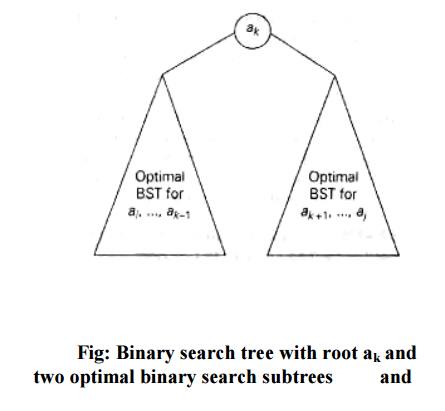
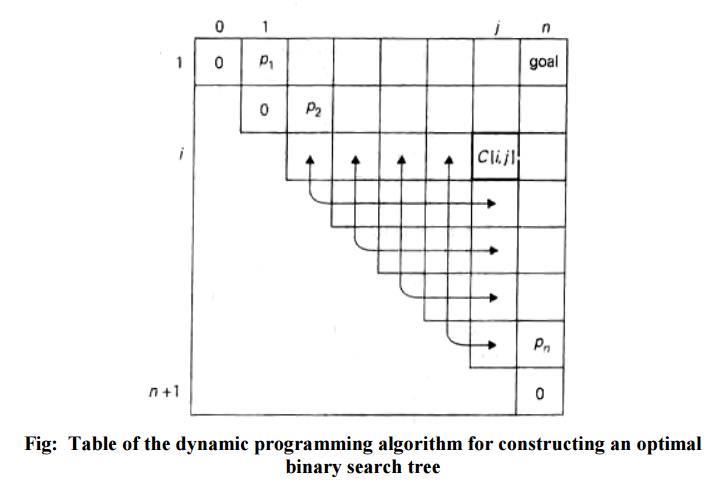
EXAMPLE 1: Let us illustrate the algorithm
by applying it to the four-key set.
Key A B C D
Probability 0.1 0.2 0.4 0.3

Thus, out
of two possible binary trees containing the first two keys, A and B, the root
of the optimal tree has index 2 (i.e., it contains B), and the average number
of comparisons in a successful search in this tree is 0.4.
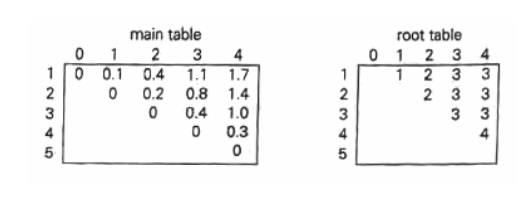
Thus, the
average number of key comparisons in the optimal tree is equal to 1.7. Since
R[1,
4] = 3,
the root of the optimal three contains the third key, i.e., C. Its left subtree
is made up of keys A and B, and its right subtree contains just key D.
To find
the specific structure of these subtrees, we find first their roots by
consulting the root table again as follows. Since R[1, 2] = 2, the root of the
optima] tree containing A and B is B, with A being its left child (and the root
of the one-node tree: R[1, 1] = 1). Since R[4, 4] = 4, the root of this one-node
optimal tree is its only key V. The following figure presents the optimal tree
in its entirety.
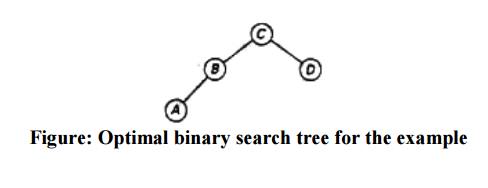
Pseudocode of the dynamic
programming algorithm
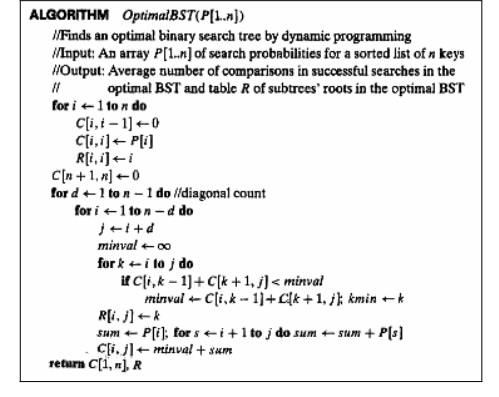
5 0/1 KNAPSACK PROBLEM
Let i be the highest-numbered item in an
optimal solution S for W pounds. Then S` = S - {i} is an optimal solution for W - wi pounds and the value
to the solution S is Vi plus the value of the
subproblem.
We can
express this fact in the following formula: define c[i, w] to be the
solution for items 1,2, . . . , i and
maximum weight w. Then
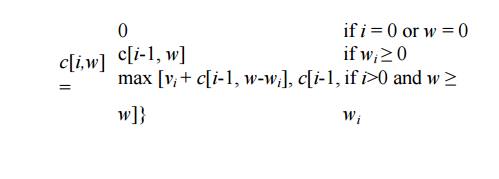
This says
that the value of the solution to i
items either include ith
item, in which case it is vi
plus a subproblem solution for (i -
1) items and the weight excluding wi,
or does not include ith item,
in which case it is a subproblem's solution for (i - 1) items and the same weight.
That is,
if the thief picks item i, thief
takes vi value, and thief
can choose from items w - wi,
and get c[i - 1, w - wi] additional value. On
other hand, if thief decides not to take item i, thief can choose from item 1,2, . . . , i- 1 upto the weight limit w,
and get c[i - 1, w] value. The
better of these two choices should be made.
Although
the 0-1 knapsack problem, the above formula for c is similar to LCS formula:
boundary values are 0, and other values are computed from the input and
"earlier" values of c. So
the 0-1 knapsack algorithm is like the LCS-length algorithm given in CLR for finding a longest common subsequence of two sequences.
The algorithm
takes as input the maximum weight W,
the number of items n, and the two sequences v = <v1, v2, . . . , vn> and w = <w 1, w2, . . . , wn>. It stores the c[i,
j] values in the table, that is, a
two dimensional array, c[0 . . n, 0 . . w] whose entries are computed in a row-major order. That is, the
first row of c is filled in from left
to right, then the second row, and so on. At the end of the computation, c[n,
w] contains the maximum value that
can be picked into the knapsack.
dynamic-0-1-knapsack
(v, w, n, w)
for w = 0 to w
do c[0,
w] = 0 for i=1 to n
do c[i,
0] = 0 for w=1 to w
do iff wi ≤ w
then if vi + c[i-1, w-wi]
then c[i, w] = vi +
c[i-1, w-wi] else c[i, w] = c[i-1, w]
else
c[i, w] = c[i-1, w]
The set
of items to take can be deduced from the table, starting at c[n.
w] and tracing backwards where the optimal values came from. If c[i,
w] = c[i-1, w] item i is not part of the solution, and we
are continue tracing with c[i-1, w].
Otherwise item i is part of the
solution, and we continue tracing with c[i-1, w-W].
Analysis
This
dynamic-0-1-kanpsack algorithm takes θ(nw)
times, broken up as follows: θ(nw)
times to fill the c-table, which has
(n +1).(w +1) entries, each
requiring θ(1) time to compute. O(n) time to trace the solution, because
the tracing process starts in row n of
the table and moves up 1 row at each
step.
6. TRAVELING SALESMAN PROBLEM
We will
be able to apply the dynamic programming technique to instances of the
traveling salesman problem, if we come up with a reasonable lower bound on tour
lengths.
One very
simple lower bound can be obtained by finding the smallest element in the
intercity distance matrix D and multiplying it by the number of cities it. But
there is a less obvious and more informative lower bound, which does not
require a lot of work to compute.
It is not
difficult to show that we can compute a lower bound on the length I of any tour as follows.
For each
city i, 1 ≤ i ≤ n, find the sum si of the distances from city i to
the two nearest cities; compute the sums of these n numbers; divide the result by 2, and, it all the distances are
integers, round up the result to the nearest integer:
lb=|S/2|
b) State-space tree of the
branch-and- bound algorithm applied to this graph.
(The list of vertices in a node specifies a
beginning part of the Hamiltonian circuits represented by the node.)
For
example, for the instance of the above figure, formula yields

We now
apply the branch and bound algorithm, with the bounding function given by
formula, to find the shortest Hamiltonian circuit for the graph of the above
figure (a). To reduce the amount of potential work, we take advantage of two
observations.
First, without
loss of generality, we can consider only tours that start at a.
Second, because
our graph is undirected, we can generate only tours in which b is visited before c. In addition, after visiting
n-1 = 4 cities, a tour has no choice but to visit the remaining unvisited city
and return to the starting one. The state-space tree tracing the algorithm‘s
application is given in the above figure (b).
The
comments we made at the end of the preceding section about the strengths and
weaknesses of backtracking are applicable to branch-and-bound as well. To
reiterate the main point: these state-space tree techniques enable us to solve
many large instances of difficult combinatorial problems.
As a
rule, however, it is virtually impossible to predict which instances will be
solvable in a realistic amount of time and which will not.
Incorporation
of additional information, such as symmetry of a game‘s board, can widen the
range of solvable instances. Along this line, a branch-and- bound algorithm can
be sometimes accelerated by knowledge of the objective function‘s value of some
nontrivial feasible solution.
The
information might be obtainable—say, by exploiting specifics of the data or
even, for some problems, generated randomly—before we start developing a
state-space tree. Then we can use such a solution immediately as the best one
seen so far rather than waiting for the branch-and-bound processing to lead us
to the first feasible solution.
In
contrast to backtracking, solving a problem by branch-and-bound ha both the
challenge and opportunity of choosing an order of node generation and finding a
good bounding function.
Though the best-first rule we used above is a sensible approach, it mayor may not lead to a solution faster than other strategies.
Related Topics